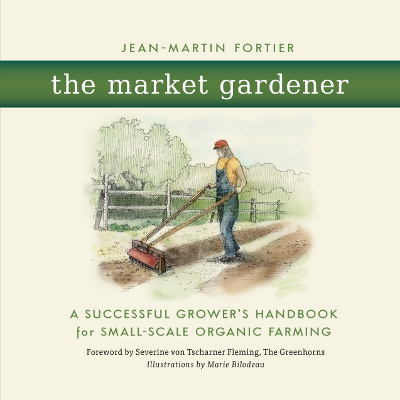
The Market Gardener
 I kept hearing good things about The Market Gardener
by Jean-Martin Fortier, but I put off picking the book up because I
have no inclination to sell any of our homegrown food. Having now
consumed this easy-to-read and gorgeously illustrated text, I now
recommend it to just about every reader on this blog. If you're
interested in producing food for a CSA or farmer's market, the book is a
no-brainer. But it's also invaluable for intermediate-level home
gardeners who want to streamline their production by focusing on
techniques that really work.
I kept hearing good things about The Market Gardener
by Jean-Martin Fortier, but I put off picking the book up because I
have no inclination to sell any of our homegrown food. Having now
consumed this easy-to-read and gorgeously illustrated text, I now
recommend it to just about every reader on this blog. If you're
interested in producing food for a CSA or farmer's market, the book is a
no-brainer. But it's also invaluable for intermediate-level home
gardeners who want to streamline their production by focusing on
techniques that really work.
Fortier's thesis is
simple --- those of us gardening or farming on less than two acres need
to minimize our startup costs, to focus on hand tools and light power
tools, and to plan for high productivity in a small space using
intensive methodology and season extension. He explains that you can
expect to net between $30,000 and $50,000 per acre per year by working
(long hours) for ten months selling directly to the public. His CSA,
located in zone 5 of Quebec, for example, feeds 200 customers off 1.5
acres and pays his family's bills while also employing 3.5 workers in
the process.
I won't go deeper into
Fortier's methodology because the book is such a delight to read with
its extensive drawings and short, punchy chapters that you're really
better off going straight to the source. However, you probably will hear more about caterpillar tunnels here in later posts since The Market Gardener explained just the method I think I've been looking for to protect crops a bit more than quick hoops
do, but without the permanence and expense of high tunnels or a
greenhouse. So stay tuned to follow along with our experimentation in
that direction this fall!
Want more in-depth information? Browse through our books.
Or explore more posts by date or by subject.
About us: Anna Hess and Mark Hamilton spent over a decade living self-sufficiently in the mountains of Virginia before moving north to start over from scratch in the foothills of Ohio. They've experimented with permaculture, no-till gardening, trailersteading, home-based microbusinesses and much more, writing about their adventures in both blogs and books.
Want to be notified when new comments are posted on this page? Click on the RSS button after you add a comment to subscribe to the comment feed, or simply check the box beside "email replies to me" while writing your comment.

Oh, great.. this might be just the thing I have been looking for. I have already ordered it.
Sort of off topic, but I wonder if you wouldnt mind saying what kind of oats you use for winter cover crop. Was wo dering if I could just buy horse oats and use those?
Deb --- I suspect you'll enjoy the book!
About oats --- we get whatever variety they have in 50 pound bags at the feed store. My garden spreadsheet says this has included Ogles, Noble, Common, and unlabeled varieties. The only problem we had was last year when I grazed the oats hard and they didn't winterkill, but I'm 99% sure that was the grazing and not the variety.
I'm not sure what horse oats are. If they're processed somehow for feed, they possibly might not sprout. But otherwise it should work. And the feed store is definitely the cheapest place to get cover crop seeds (by an order of magnitude sometimes!).
Excellent book! He's also an excellent speaker if you ever have a chance to attend a workshop in your area.
Oat variety does matter, or actually type. Spring oats, aka white oats may winter kill if you have cold enough weather,fall oats aka grey oats will not winter kill because they are meant to survive winter for a spring crop of grain. It's hard to know what you're getting if you just buy feed oats, as seed crops are much cleaner, meaning less weed seeds by law. So if you want oats to have a chance to winterkill, buy white oats. Even seed sellers get confused if you ask for oats to plant in the fall, because they assume you want them to survive. We never get cold enough weather for winterkill oats or barley, so I'm switching to sudan grass which really puts on biomass. With no irrigation, my sudan is already a foot tall + in less than a month.
Since I didn't know what a caterpillar tunnel is I googled it, and came across this article.
Some quotes:
and
Thanks Anna and Nita for the oats comments. I meant feed oats when I said "horse oats".
I have used caterpillar tunnels, and find that theu provide about 4 degrees of frost protection.... with just the agribon row cover. With plastic, its more than that. I make mine out of 10 ft. Pvc, and make the hoops about 4 feet tall.